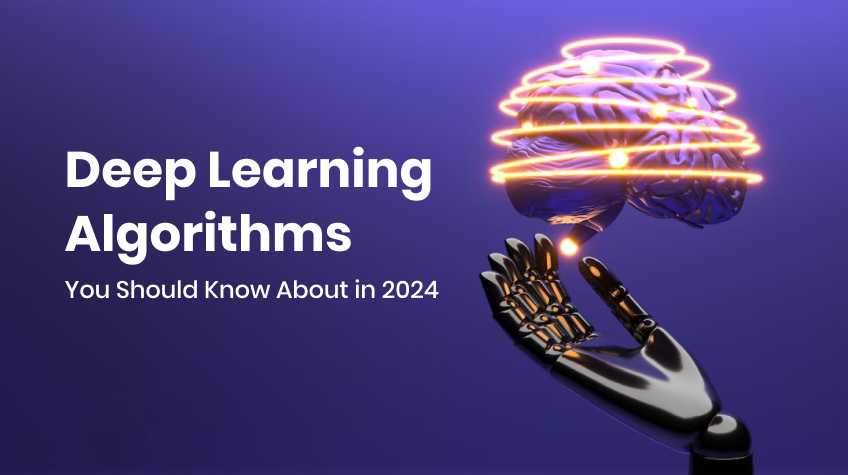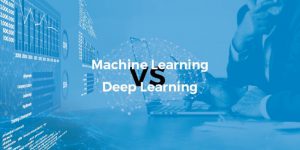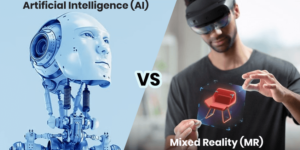
Wondering what deep learning algorithms are?
If yes, then you are reading the right article! This article gives you a detailed view of algorithms and neural networks that are responsible for making the user’s life smarter. No one would believe these algorithms can train machines to predict their users. Surprisingly yes! Keep exploring to unwind the superpowers of deep learning algorithms.
Welcome to the rapidly evolving landscape of deep learning algorithms!
In this ever-evolving technical realm, people witness changes every day. The world is moving toward advancements. From button phones to sensor-access gadgets, the world is moving towards a revolutionary tomorrow, isn’t it? Yeah! AI gadgets, smart accessories, and many other innovative technological inventions make everything possible.
You already know that Siri and Alexa can answer any question without any reliance on humans.
But do you ever wonder how it happens? Or how is it possible?
Well, it’s possible today! Advanced technologies like Artificial Intelligence, Machine Learning, the Internet of Things, Natural Language Processing, and Deep Learning do the magic. These technologies and notable inventions are reshaping the daily lives of their potential users.
In that instance, you need to be aware of the latest technologies and algorithms. Thus, let’s witness what deep learning algorithms do and how they enhance the applications in this article.
Without any further ado, let’s get started!
Table of Contents
- What Is a Deep Learning Algorithm? How Does It Work?
- Types Of Deep Learning Algorithms
- Convolutional Neural Networks (CNNs)
- Long Short-Term Memory Networks (LSTMs)
- Radial Basis Function Networks (RBFNs)
- Multilayer Perceptrons (MLPs)
- Restricted Boltzmann Machines (RBMs)
- Autoencoders
- Self-Organizing Maps (SOMs)
- Generative Adversarial Networks (GANs)
- Deep Belief Networks (DBNs)
- Recurrent Neural Networks (RNNs)
Let’s discuss deep learning algorithms! But first of all, do you know about deep learning? Let’s begin with the fundamentals of deep learning algorithms. Here we go…
What Is a Deep Learning Algorithm? How Does It Work?
Deep learning is a method in AI that teaches the computer to process data in a way similar to the human brain. It is made up of a neural network with three or more layers, including the Input layer, Hidden layers, and Output layers.
Deep learning models can recognize complex patterns in different files, such as pictures, text, sound, etc., to produce insights and predictions. This technology is crucial for AI-based applications to detect fraud and automatic face and voice recognition.
In general, algorithms are a vital part of programming because they help to understand the logic before initiating the process. Similarly, deep learning algorithms help determine the accuracy of predictions. It can easily handle large and complex datasets, which is difficult for traditional machine learning algorithms to handle.
Now, it’s time to learn about the top deep learning algorithms. Here we go…
Types Of Deep Learning Algorithms
Deep learning effectively eliminates the dependency on human experts and helps to take over the complete process. Here is our rundown of the different types of deep learning algorithms for you to learn. Take a look…
1. Convolutional Neural Networks (CNNs)
Convolutional neural networks, popularly known as CNN, are neural networks used to process images and videos. Convolution, Rectified Linear Unit, Pooling Layer, and Fully Connected Layer are the various building blocks of CNN. This is considered one of the best deep learning algorithms that have parameter sharing, translation invariance, local receptive fields, and pre-trained models.
Every building block performs a specific task efficiently and generates highly accurate outputs for the users.
Applications of Convolutional Neural Networks
Facebook, Instagram, and other social media handles use CNN to detect and recognize faces. To give an idea, you’re using CNN when you tag your friends in any of your posts. Besides social media sites, other applications that include deep learning algorithms are video analysis, image recognition, forecasting, and Natural Language Processing, which can use CNN.
Pros:
- Process large amounts of data and generate accurate predictions
- Efficient image processing and robust to noise, which means it can recognize patterns even when inputs are corrupted
Cons:
- It is not a cost-effective algorithm and consumes more time
- High computational requirements and quite slower
2. Long Short-Term Memory Networks (LSTMs)
Long Short-Term Memory Networks, also known as LSTM, is a specialized type of RNN architecture used in deep learning. It is exclusively designed to overcome the traditional RNN cons. The default feature of this model includes recalling past information for a long period, which simply means memorizing long-term dependencies.
So, if you’re using it in an application, then you can retain information over time. This architecture has different memory blocks known as cells, and it changes the memory from one cell to another. Through this mechanism, it effectively recalls and predicts accurately.
Applications of Long Short-Term Memory Networks
In general, this deep learning algorithm is used to learn, process, and classify sequential data. Other common applications include sentiment analysis, language modelling, video analysis, and speech recognition. Plus, anomaly detection in network traffic data, time series forecasting, and auto-completion can also be effectively performed using LSTMs.
Pros:
- Handling long sequences and variable-length sequences
- Avoiding the vanishing gradient problem
- Memory cells and gradient flow control
Cons:
- Computational complexity
- Long training time and limited interpretability
- Overfitting and hyperparameter tuning
3. Radial Basis Function Networks (RBFNs)
Radial Basis Function Networks, or RBFNs, are a special type of feedforward neural network. They have three layers: the input, hidden, and output layers. RBFNs use the trial-and-error method to determine the network’s structure and are performed in two steps.
The first stage involves the hidden layer utilizing an unsupervised learning algorithm, followed by the determination of weights through linear regression. The Mean Squad Error (MSE) is used to determine the number of errors present, and the weight is adjusted in order to minimize these errors.
Applications
RBNF has the ability to work on time-series-based data, which it uses in analyzing stock market prices. Plus, it is used to forecast sales prices in retail industries. This neural network effectively recognizes speech and images and does time-series analysis, medical diagnosis, and adaptive equalization. Thus, applications that need to perform such functions can utilize this technology.
Pros:
- No backpropagation is included, and the training process is faster.
- It is easy to interpret the roles of the hidden layer nodes
Cons:
- The overall training is faster, but classification consumes more time compared to other models
- It may not be suitable for high-dimensional data
4. Multilayer Perceptrons (MLPs)
Are you confused about where to start gaining knowledge about deep learning technology? If yes, then you should prioritize Multilayer Perceptrons. Multilayer Perceptrons, popularly known as MLPs, are the basic deep learning algorithms. These algorithms make learning easier for beginners.
Multilayer Perceptrons train the models to understand the correlation and assist software in learning the dependencies between independent and target variables.
Applications of Multilayer Perceptrons
MLPs are used by myriads of social media sites, including Facebook and Instagram. These sites use MLPs for compressing image data. That’s the reason users are able to load the images even if the network strength is weak. These deep learning algorithms are also used to build image and speech recognition systems or other types of translation software. Other than this, it is used for solving classification problems and data compression.
Pros:
- Unlike other probability-based models, MLPs don’t make any assumptions regarding Probability Density Function PDF
- After training the perceptron, this can provide the decision function directly
Cons:
- MLPs can only offer outputs in 0 and 1’s because of the hard-limit transfer function
- This network may get struck while updating weights in the layers, which may hinder accurate results
5. Restricted Boltzmann Machines (RBMs)
Restricted Boltzmann Machines, or RBMs, are yet another important type of deep learning algorithm. These algorithms offer various stunning features. These features include dimensionality reduction, classification, regression, collaborative filtering, and topic modelling.
This deep learning algorithm consists of two layers, including visible units and hidden units. These two layers are connected to a bias unit. Using the two phases, forward pass and backward pass, this algorithm effectively performs the work.
Applications of Restricted Boltzmann Machines
RBM deep learning algorithm plays a pivotal role in customized recommendations. Many popular streaming applications, like Netflix and Amazon Prime Video, use this deep learning algorithm for user-based recommendations. If you have ever noticed, you get customized recommendations whenever you search for a movie or series on Netflix. This is because of the Restricted Boltzmann Machines. Other than this, this algorithm allows you to recognize patterns, classify problems, perform topic modelling, and feature extraction operations in neural networks.
Pros:
- There is no need for high computation because it can encode any distribution
- This can be pre-trained in an unsupervised way and can model complex, high-dimensional data
Cons:
- RBM faces challenges while training the calculation of the energy gradient function
- Adjusting weight is quite difficult; that is not as easy as backpropagation
6. Autoencoders
Autoencoders are a type of unsupervised algorithm. It is utilized to transform multi-dimensional data into a lower-dimensional representation.
The reconstructing process involves three main components: the encoder, coder, and decoder. The encoder takes the input and compresses it into a representation in a latent space. This compressed representation is commonly referred to as the code. The decoder is responsible for reconstructing the code back to its original form.
The code layer, which is sometimes referred to as the bottleneck, plays a crucial role in the reconstruction of the input. Bottlenecks play a crucial role in determining what is important and what can be disregarded in the final outcome.
Applications of Autoencoders
Autoencoders are considered the best deep learning algorithms for colouring and compressing images. They are commonly used in the healthcare industry for medical imaging (the process of imaging the human body’s interiors) and dimensionality reduction. Apart from this, they are also used to generate images and time series data.
Pros:
- The usage of multiple encoder and decoder layers reduces the computational cost
- Successfully capture most of the characters of the input while reconstructing the data
Cons:
- This effectively reconstructs the simple images but struggles while generating complex images
- After encoding, you may witness the loss of essential data in the input
7. Self-Organizing Maps (SOMs)
Visualizing data is the most important thing for a successful business. In such a situation, Self-Organizing Maps, commonly known as SOMs, come in handy.
SOM is one of the best deep learning algorithms that generates various dimensional data to satisfy users’ requirements. This reduces data dimensions, which means this deep learning algorithm eliminates the less relevant features. In addition, this deep learning algorithm categorizes the information using various colors, so users can easily analyze and visualize large amounts of data.
Applications of Self-Organizing Maps
Using SOMs, you can perform a variety of tasks, including image analysis, fault diagnosis, and process monitoring. This deep learning algorithm is more valuable for the healthcare sector. This is because it allows you to create 3D human heads from images and provide powerful visualization.
Pros:
- Easily interpret and understand the data
- Checking similarities is easier with dimensionality reduction
Cons:
- If you provide less or extensive data, then you may not get accurate output
- Obtaining a perfect mapping where groupings are unique within the map can often be challenging.
8. Generative Adversarial Networks (GANs)
Generative Adversarial Networks, or GANs, are generative deep learning algorithms. It creates new data instances resembling the original data. Whether it is a tree or a person, GANs efficiently generate the input using the two components. They consist of a generator that creates fake data and a discriminator that learns from this fabricated information.
Both the generator and discriminator neural networks are trained simultaneously, each striving to outperform the other.
Applications of Generative Adversarial Networks
Generative Adversarial Networks are widely used in marketing, advertising, e-commerce, games, hospitals, etc. Users can generate images for story-writing stuff like novels and others using these deep learning algorithms. In addition, GANs are also used for generating videos and images. Take a look at some of the pros and cons of GANs.
Pros:
- You can easily recognize streets, bicyclists, people, trees, and parked cars, and also calculate the distance between different objects using GANs
- They help generate data similar to original data and different versions of text, video, and audio
Cons:
- Harder to train, you need to provide different types of data that consume more time
- The accuracy of the generated image is comparatively less than that of the original image
9. Deep Belief Networks (DBNs)
Deep Belief Networks, also known as DBNs, are yet another important deep learning algorithm. These algorithms resemble deep neural networks and are built by appending RBM layers. They are pre-trained using the Greedy algorithm and follow a layer-by-layer approach to determine how variables rely on each other in every layer. This algorithm is known for its efficiency in utilizing hidden layers, as it offers a higher performance gain when compared to the Multilayer Perceptron.
Applications of Deep Belief Networks
This deep learning algorithm plays a vital role in various sectors, including image recognition, financial forecasting, healthcare and medical imaging, drug discovery, and bioinformatics.
Pros:
- The DBN algorithm makes classification tasks, particularly handling variations in size, position, color, and view angle (including rotation), a breeze
- The same neural network approach used by DBN can be applied to a wide range of applications and data types
Cons:
- Complexity in computing and longer training time
- Difficulty in interpretability and limited applicability
10. Recurrent Neural Networks (RNNs)
Recurrent Neural Networks, or RNNs, is a specific type of artificial neural network. They are particularly used for handling sequential data and conducting time-series analysis. RNNs, unlike traditional feedforward neural networks, have connections that create a directed cycle. Also, they allow inputs from the LSTMs. Yes, hope you remember the above-discussed section on LSTM. This algorithm approach is interconnected with the upgraded algorithm Long Short-Term Memory Networks. This unique feature enables RNNs to demonstrate dynamic temporal behaviour.
Applications of Recurrent Neural Networks
RNNs are highly effective in tasks like natural language processing, speech recognition, and image captioning because they can capture the importance of data order and context. Recurrent Neural Networks (RNNs) are specifically designed to handle inputs of varying lengths and have the ability to retain memory of past inputs. This makes them highly suitable for tasks that require considering context or historical information.
Auto-completion is an effective application of this deep learning algorithm. Search engines and web browsers like Google use RNN to auto-complete sentences and words. In addition, this deep learning algorithm is used in applications that need to detect and recognize text, analyze video frames, and perform other automation processes.
Pros:
- Effectively handles sequential data like text, speech, and time series
- Can process the input of any length and share weights across time steps
Cons
- Training can be challenging due to gradient problems
- Long sequences can be even more challenging
- Comparatively slower than other neural network architectures on a computational basis
Final Words
Hope you all get some ideas about algorithms after exploring this deep learning algorithms list along with their applications and advantages. In this ever-evolving technical realm, embracing new revolutionary inventions is undeniably important to enhance your standards. Along with that, try to gain knowledge of advanced technologies like artificial intelligence, Deep Learning and Machine Learning to understand their working mechanisms. Knowledge of these methods can help you automate tasks that traditionally rely on human intelligence. These tasks include describing images, converting a sound file into written text, and much more!






